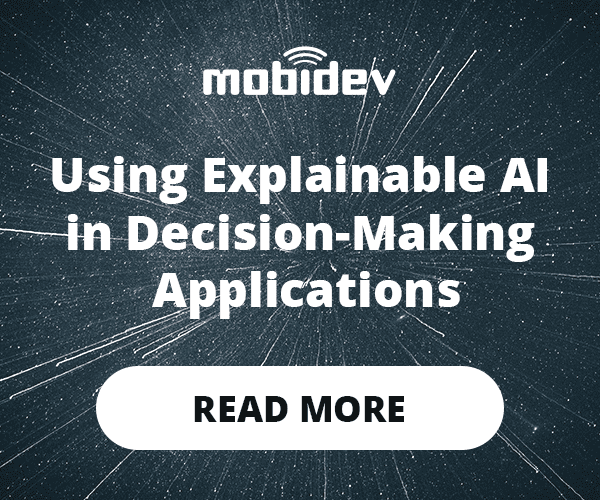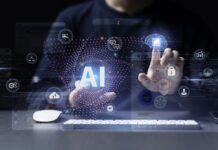There is no doubt that human error is the most significant contributing risk factor in safety-critical systems. In manufacturing, transportation, healthcare, security, and even marketing, human error can lead to tremendous losses. While it might not be possible to cut out every preventable mistake, Artificial Intelligence (AI) takes center stage in the future of business intelligence.
AI Can Help with Decision Making
Today companies have to deal with huge amounts of data in order to meet the needs of their customers. The challenge is to turn this data into tangible outcomes that can be used to improve the efficiency of the workflow. The speed and quality of processing this information is the key, and that’s where AI can show all its power. AI is great at data categorization and forecasting, and the ability of this technology to self-learn makes its implementation justified in order to achieve long-term results.
Thanks to AI, data analysis tools are able to efficiently process a large amount of information.
The ability of AI to quickly assess large volumes of data gives it distinct advantages over human decision-making in many different scenarios.:
- Clear strategic planning. AI makes data-driven management possible, where the increased accuracy of information allows plans and goals to be set based on real-world performance. AI-powered strategic planning improves the visibility of the planning chain and the process of achieving goals, making it possible to clearly define the result that can be measured.
- Improved customer experience. AI helps companies to better understand the needs and pains of their customers, and build more customer-centric strategies based on the insights they find. AI virtual assistants or chatbots allow you to process information in real-time and provide users with personalized customer services.
- More effective marketing campaigns. AI and machine learning in marketing not only improve social listening by automating the process of collecting mentions of your brand but also allow companies to provide smart recommendations to customers or even automatically generate content. This can be done through generative adversarial networks, or GANs, for images and BERT or GPT approaches for text. Also, artificial intelligence helps to increase the effectiveness of advertising campaigns through automated ad testing and the inclusion of automated optimization strategies.
- Better performance assessment. Automating the performance evaluation process with the help of AI makes the process of business results evaluation more transparent for all team members. With the help of AI algorithms, you can accurately assess which strategy is working and which is not working and make further decisions based on this data.
Let’s look at an example. Say that you run a parking company that used to chalk car tires to track when vehicles entered and exited the lot. It was up to the discretion of the parking employees to make rapid assessments on which visitors should be given a citation, assuming that the employee was even able to circle through the lot in time to catch a violation. Pioneering parking companies deploy the same technology utilized by police: vehicle-mounted cameras hooked into a patrol and passport ticketing system. AI decision-making technology deployed in-field allows the computer to track vehicles in real-time by license plate, checking how long vehicles have been sitting in the lot each time the security vehicle’s cameras scan the parking lot. For these and other companies, integrating AI results in increased profits, quality-of-life improvements for employees, simplified data collection and auditing, and higher accuracy rates across the board.
Degrees of AI Involvement in Decision Making
Though humans tend to make a certain amount of errors in judgment, they are still crucial to the decision-making process. Artificial Intelligence is implemented to different degrees or at different stages in the process, involving more or less direction from human agents.
- In the Decision Support model of AI decision-making, human employees ultimately still make the decisions but are supported by data-driven insights from AI tools. For situations where human intuition, knowledge, and emotions are still required, this is the ideal implementation.
- Using Decision Augmentation, the AI system draws up decisive options for a human agent to select from, synergizing human knowledge and capabilities in concert with the AI’s ability to make rapid-fire inferences from large datasets.
- Total Decision Automation puts the power in the hands of the AI model to make decisions in a situation based on predictive or prescriptive analytics.
How to Handle Trust Challenges with Explainable AI
Naturally, there are concerns both from an ethics and design perspective about the trustworthiness of AI systems. Many AI implementations effectively function as a black box, with the internals and heuristics unexposed or unexplainable to human agents.
The fledgling field of Explainable AI (XAI), a discipline within Machine Learning, aims to address the trust challenges of Artificial Intelligence by showing how and why AI makes particular decisions. Exposing the internal heuristics of AI systems not only offers improvements in privacy and security, but also helps humans better understand, direct, and program AI systems for increased performance, power, and accuracy.
Explainable Artificial Intelligence inspects and ascertains the AI’s steps to generate the output, making it much easier to see where the system succeeded, failed, and did what it did. There are many higher-risk situations where understanding the logic behind the AI’s internals is crucial. For example, in medical data analysis, suicide prediction, financial planning, autonomous vehicles, fraud detection, and more. Big organizations like the US Defense Advanced Research Project Agency (DARPA) are currently exploring workable AI explainability models, and the prospects for AI transparency look excellent.
Real-world Use Cases for AI Decision Making
There are a lot of use cases for AI adoption in decision making and their numbers are growing.
In the healthcare sector, Computer Vision (CV) implementations help produce faster and more accurate diagnoses of illnesses. Infravision, an AI medical technology company, has developed an AI utilizing Computer Vision that reviews CT scans, searching for the early signs of lung cancer. Having the assistance of an AI helps increase detection rates in the industry, which is already lacking enough radiologists to meet present demand.
The financial industry also has some interesting AI products, such as Underwrite.ai, which assesses credit risks for consumer loan applications and small businesses by making quick decisions based on data pulled from credit bureaus.
AI-driven decision-making enables personalized marketing at its best. The collection and processing of user data allow a company to tailor its communications to the needs of a particular user. For example, the Trip Advisor app uses data about the user’s previous activities to send personalized messages such as booking recommendations or reminders.
Amazon’s in-house recommendation engine, known as Flywheel, started as a quick napkin sketch by Jeff Bezos before it was eventually implemented as an AI tool within the company. Flywheel pulls data from Alexa, Amazon Go, and Amazon itself to recommend products and services to customers across its many different platforms. A customer who listens to an audiobook on a particular topic on Audible later receives related product recommendations the next time they visit Amazon. The whole engine seamlessly recommends products to customers likely to convert into purchases.
Volvo, an automotive brand famous for providing superior safety features to customers, implemented AI in its cars to reduce accidents. The on-board AI monitors driving conditions with a host of sensors, making split-second decisions to reduce accidents and fatalities. The company plans to utilize Machine learning models to predict failures and breakpoints in its vehicles soon as well.
The Big Takeaway for Companies
The forward march of Artificial Intelligence seems inevitable. As AI enters every conceivable industry, solutions will continue to get smarter and easier to implement. Companies that get on board earlier than later have the distinct advantage of being first-to-market in the fledgling AI industry.
Even partially implementing decision-making AI models into flows helps companies increase sales, provide better customer service, and deliver superior products. Giving human agents data-driven analysis from AI systems helps them make much more clever decisions. Handing over the decision-making power to AI in scenarios removes the need to fill that role with a human agent altogether, opening up new possibilities for companies to budget following changing capabilities.
About the Author

Oleksii Tsymbal, Chief Innovation Officer at MobiDev. We run a software engineering company with offices in the US, Ukraine and Poland. I’m a part of the business team and in charge of marketing and innovative technologies. I lived in Kharkiv, a great city that today is under Russian attack. So had to move to safety along with our Kharkiv office. Today I’m working in Chernivtsi, missing my native city and recently renovated apartment. But most of all I miss my family as I had to send them abroad, and my parents who refused to leave Kharkiv.




































